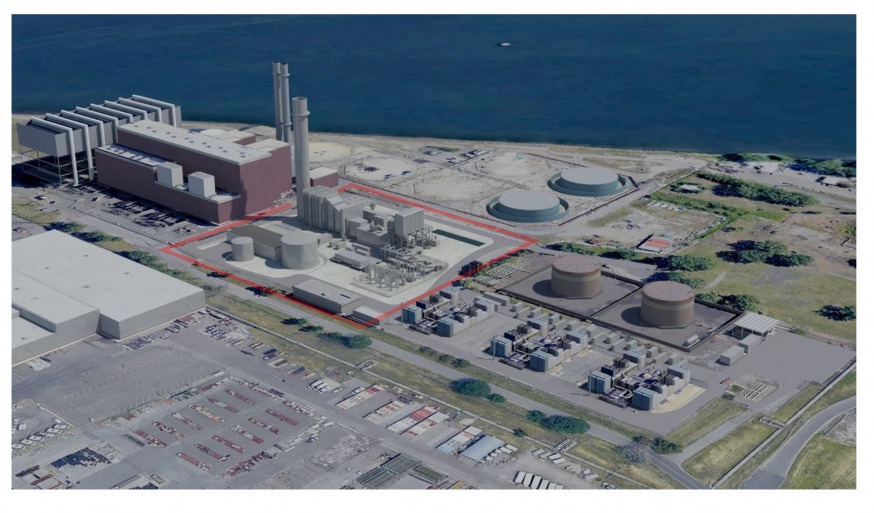
The 15-acre NRG plant in Astoria (Rendering NRG)
Feb. 9, 2021 By Christina Santucci
An Astoria assemblyman is hosting a virtual trivia show tonight – and the daily double will be about a proposal to upgrade a western Queens power plant.
NRG, one of the largest energy companies in the country, is planning to update its Astoria power plant, which the company says will lower emissions, reduce electricity costs and provide jobs.
Several Queens politicians, including Assembly Member Zohran Mamdani, oppose the project since the plan still involves the burning of fossil fuels. Instead, they want the plant to generate power through renewable energy sources.
Tonight’s event, called “Climate (in) Jeopardy!”, will be hosted by Mamdani and will feature Council candidate Tiffany Cabán, author Jaya Saxena and actress and writer Mara Wilson.
NRG plans to replace its 50-year-old power generators at its “peaker” plant in 2023. The plant, located at 31-01 20th Ave., takes up 15 acres within the 300-acre Con Edison complex, bordered by 20th Avenue, the East River and the Steinway Creek.
NRG bought the plant from Con Ed in 1999.
The plan to overhaul the plant is called the Astoria Replacement Project.
Right now, the site has 24 gas turbine units with a capacity of 500 megawatts. NRG wants to replace the units with a single, “state-of-the-art” combustion turbine generator, capable of generating 437 megawatts.
The “peaker” plant’s primary function is to provide power during high — or peak – demand to prevent blackouts, and to support the existing grid in case of emergencies.
Changes to the facility were originally proposed and approved in 2010, but were not completed because of “prevailing market conditions,” an NRG official said. That plan had been for a 1,040-megawatt project, occupying all 15 acres of the site and operating most of the time.
The energy company revised its proposal last year back to a “peaker” plant, and the modified $350-million plan is currently going through an approval process through the Department of Environmental Conservation (DEC) under the State Environmental Quality Review Act.
During a meeting about the proposal last month, NRG’s Vice President of Development Tom Atkins touted anticipated reductions to greenhouse gases emissions through 2035. He estimated nearly five million tons – or the equivalent of taking 12 percent of the cars registered in Queens off the road – would be reduced through the proposed upgrades.
Officials from the power company also said the plan is expected to reduce electricity costs for customers by $1.3 billion over the first five years. In addition, a study that projected the upgrade would result in $156 million in the state’s economy during the construction phase, as well as 510 jobs during construction and 73 jobs once the facility is up and running.
Although several Queens residents expressed support for “high-paying,” union jobs during the meeting, Mamdani criticized the number of positions that the plant would create.
“Why should Queens even consider choking itself on NRG’s pollution for economic benefits that are either temporary or at a limited scale?” the assembly member asked.

The 15-acre NRG plant in Astoria (Rendering NRG)
NRG officials said their current proposal would use half of their 15-acre site and leave the other half open for possible renewable energy uses.
But State Sen. Michael Gianaris questioned whether the facility would actually switch over to renewable sources such as hydrogen fuel any time soon. “That seems short of a commitment to do anything in the future,” the state senator said.
In response, Atkins said that if the facility doesn’t have zero-carbon emissions by 2040, the plant would have to shut down based on the Climate Leadership and Community Protection Act.
Later in the meeting, Council Member Costa Constantinides noted that his son and many other children in Astoria have asthma — a condition linked to air pollution caused by fossil fuels.
“I will again implore you to find another way,” he said. “You delayed the project in 2010, and now you are coming to this community with an outdated project.”
The project was initially approved in 2010 under the State Environmental Quality Review Act, when the regulations used to evaluate power plants required less public participation.
State Sen. Jessica Ramos said she has asked the governor for an enhanced public review process for the proposal under the DEC’s environmental justice policy.
Ramos is adamantly opposed to the plan.
“As long as fossil fuels are being burned in our community, this project is going to remain unacceptable to us — union jobs or not,” Ramos said.
NRG officials said that they recognize the calls for clean energy, but argue that proposed plant–that will be fueled by gas–is needed as a bridge to renewable sources. “The problem is there is going to be a period of transition where we need to have to have gas-fired units to provide backup service at least until 2040,” Atkins said.
Atkins also said that there could be power shortages if the Astoria turbines are retired–as currently planned on May 1, 2023—and not replaced.
“So, if our replacement project does not move forward, something else would have to be done instead to ensure that the lights stay on in New York City,” he said.
However, later in the meeting, Atkins said that existing equipment could possibly be kept running beyond 2023 if needed to address “reliability issues.”
NRG officials said the public will be able to comment on the project during one additional public meeting, which will be hosted by the DEC. The date and time of the meeting has not yet been announced.
In addition, comments and questions can be submitted to the DEC at comment.nrgastoriagas@dec.ny.gov.
Those interested in the “Climate (in) Jeopardy!” event from 7:30 to 8:30 p.m. Tuesday, can register at https://bit.ly/climatejeopardy.
2 Comments

“Instead, they want the plant to generate power through renewable energy sources.”
Our politicians are scientifically illiterate. It is impossible to replace this plant with “renewable” energy (which itself creates massive amounts of pollution). Germany stupidly went down the Green road, and now they are facing a power grid collapse and people freezing from lack of power. Plus their electricity costs a fortune.
Enough with ignorant politicians virtue signaling about something they don’t understand in the least.
Hydrogen fuel is charged with Carbon. At least inform yourself on various energy sources before spouting off things that sound good but are impractical. So you are essentially proposing that a “backup” powerplant that is intended to ensure reliable energy so that New Yorkers are not subjected to blackouts if there are strains on the system should not be able to go forward with upgrades? Soon we will truly be living in a third world city with rolling blackouts. Not to mention the fact that renewables like wind wouldn’t be able to replace the capacity of a gas powered plant and would send electric and heating bills through the roof for many New Yorkers who can’t afford it. Typical politician … jump on the bandwagon without providing any informed, practical or viable solutions. These statements / decisions that you are making now will not be forgotten when New Yorkers start suffering the consequences that you fail to mention. And please read up on hydrogen before making statements like that. Fossil fuels are burned to create hydrogen. It is not emission free. Inform yourself.